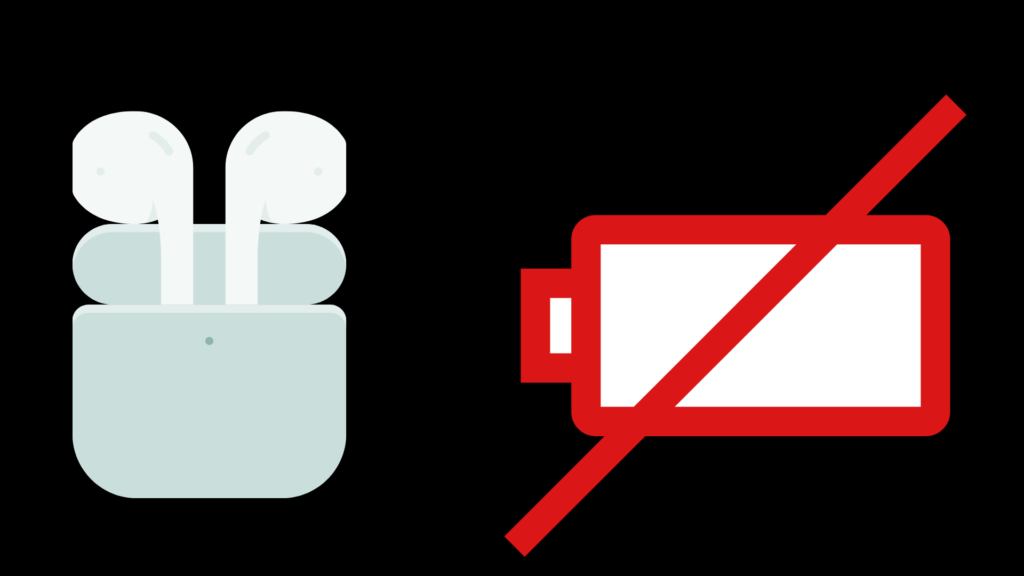Why Are My AirPods Dying So Fast?

Owning a wireless device that needs to be recharged every hour or two can feel worse than not having a device at all. If your AirPods are losing their charge in a fraction of the time advertised, this information will help you diagnose the problem and determine if there are any solutions to making them functional again.
The Causes of Battery Drain in AirPods
There are a few common causes of lost battery capacity, and it’s a simple reality of using rechargeable devices. No known technology will store and release a charge without some form of capacity loss.
Battery Failure over Time
Rechargeable batteries lose a portion of their maximum charge over time over the course of normal usage, partially influenced by how often they undergo the recharging cycle. The loss is normally a slow fade that you won’t notice without measuring the battery duration from day to day, but it’s fast enough to potentially cause problems within the AirPods’ warranty period when combined with other sources of loss. Nearly all the other issues can exacerbate the rate of loss over time.
Louder Sound Requires More Power
AirPods are like other electronic speakers that use an electrical charge to drive the voice coil inside of each one. To make the coil vibrate more and create a louder sound, it takes more current. When you draw more current, it takes the battery’s power away more quickly. This also leads to faster long-term battery degradation due to the faster current discharge.
Damage to the AirPods
AirPods are delicate arrangements of plastic and technology. The components of AirPods are closely nestled together, and they are held together with glue and careful engineering. A direct blow to either one of the AirPods might lower its overall capacity or cause some parts to bleed away more power. It’s also a potential cause of one battery suffering from more capacity loss than the other.
Running Advanced Audio Processing Features
Sound processing functions that take more Bluetooth communications from the AirPods will have an impact on the tiny battery’s charge life. For example, Spatial Audio relies on accelerometer data sent from the AirPods to the connected device. Three axes of motion are constantly being measured and reported, potentially a hundred times a second. Apple estimates Spatial Audio removes an hour of listening time from the 6-hour starting capacity of 3rd generation AirPods.
The features might drain from both AirPods the same amount, but there are cases where they won’t. For example, a slight shift in the audio balance might cause one to consistently be 10% louder than the other. If you have mild hearing loss in one ear, this could be intentional, but it also causes an uneven amount of battery drain.
How to Tell If Your AirPods Are Dying Faster
According to Apple, the AirPods should have 5 hours of audio time at 50% volume using a pair of 2nd generation AirPods and 6 hours of audio time for the 3rd generation. As Apple mentions in the footnotes, how fast the battery drains depends on a number of factors, so it’s best to copy their test to get a realistic sense of your battery’s charge life. That includes checking the encoding on the used audio tracks, though you don’t really have to use the exact same number of songs.
Charge the AirPods to full, turn on the music, and start the timer. Let the AirPods play until they run out of battery. Keep an eye on the battery for both the left and right AirPods. They will both shut off when one runs out of power, but the drain is frequently lopsided even without a battery issue. One battery might have more overall capacity loss, as well.
Once they shut off, write it down. Like any test, it helps to repeat it a few times to be certain. Compare the test average to the expected result. If the battery is dying faster than expected, you know that you have a battery issue. Unfortunately, this does not tell you the exact reasons for the lost duration.
How to Fix the Batteries in AirPods
It is not impossible to replace the batteries in AirPods, but it is difficult due to the battery’s size, location, and installation method. It has a high likelihood of falling under the ‘no unauthorized modifications’ part of the AirPods’ Apple warranty, so any attempt could void a warranty. If you’re considering fixing it yourself, though, you probably don’t have one.
If the AirPods are still under warranty or you signed up for AppleCare coverage, you can contact Apple to exchange the old pair for a new one at no charge. There is a fee for anyone else looking to replace the battery. It’s less than the cost of a new set of AirPods, but not by much.
As an alternative, there are people who will swap your pair of dying AirPods for a refurbished pair with an old battery. There is still a fee, but it’s about the same cost as replacing just one AirPod through Apple. Anything refurbished has a slight risk of failure, but the swaps seem legit if you’re looking to cut almost half the price of an out-of-warranty battery replacement.
Extending AirPods Battery Life
You can’t actively make your AirPods’ batteries last longer or stop degrading further, but you can take steps to slow capacity loss. An important note is that these steps apply to Lithium-ion batteries like the ones in AirPods, so some specifics do not apply to all rechargeable batteries.
- Avoid fast charging unless needed.
Pushing current into a battery more quickly can lead to more heat that causes damage. The AirPods do not actually use a fast-charging system to take charge from the case; they just have a small battery that can charge extremely quickly, even at a reasonable current.
- Avoid extreme heat.
Heat lowers the electrical resistance of an object, causing more current to flow, which generates more heat. Engineers know this and take steps to minimize the impact through circuit design, but it is a problem that cannot be avoided when the heat gets too high. Other components in electronics don’t like being hot, either, but battery life is one way the heat causes problems.
- Low temperatures can also cause problems, particularly when charging.
Any extreme will cause issues with a delicate instrument. For Lithium-ion batteries, you should avoid charging them below freezing temperatures and be wary of fast charging just above freezing. Using the AirPods at those temperatures is less of an issue, but wait till you get to a warm spot to recharge them.
- Don’t keep the battery at full charge for long.
Storing a battery at full charge or keeping it consistent at 100% can take a toll on its battery life. If you turn on the Optimized Battery Charging feature in the 3rd generation AirPods and AirPods Pro, the software tracks your usage habits and helps with avoiding a full charge while not in use. Otherwise, this one can be taxing to maintain over time.
- Try not to fully drain the battery, and don’t leave it drained for long.
When a battery is drained completely and left that way, it will continue to lose the minuscule amounts of charge left until the low power triggers a failsafe inside the battery that prevents it from being recharged without an electrical jumpstart.
- Treat your AirPods delicately.
AirPods are small enough to fall into a couch cushion, and they are not incredibly sturdy. They can survive some drops onto hard surfaces thanks to their light weight, but a few hard knocks can start to rearrange the components inside. Don’t forget that you put them in your back pocket when you go to sit down later.
- Lower the volume.
Wanting your music to be crystal clear is understandable, but running your AirPods at a high volume will drain them faster and cause more capacity loss. If the batteries are in good condition, this shouldn’t be necessary. Still, it’s an option to keep in mind when looking to extend their battery duration.
AirPod Charging Issues
If your AirPods are dying quickly, problems with the charger will make using them even harder. The case has a rechargeable battery, too, so its total capacity will diminish over time. The same practices for managing the AirPods’ battery generally apply to its case. That includes the difficulty with repairs, ways to extend the battery life, diagnosing the problem, and the ability to send the case to Apple for a replacement if the battery is failing.





